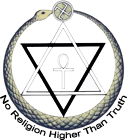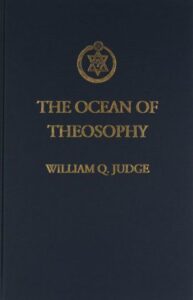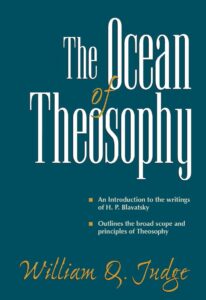Studies In The Ocean of Theosophy Part XXXI
Theosophy Magazine
Vol. 23, No. 7 May 1935
pages 319 - 322
Part XXXI
IN this world of conditioned existence, Man’s position is anomalous, at best; while regarding himself native to Earth, he at the same time constantly questions as to his presence here. To the Whence, Whither, and Why of the successive generations of Humanity both Religion and Science essay unsatisfactory answer.
Claimants of the authenticity of the Bible as the inspired literal word of God skate on thin ice. For instance, take the Garden-of-Eden version of creation: if Adam and Eve had no parents, why did their own offspring and the rest of us require them? Was it that the Almighty “lost his knack” in that one supreme effort to construct a human form? Again, if said Biblical forebears and their immediate family constituted the entire racial stock of that day, how could marriage have been arranged for their son; and how could he have gone forth and “founded a city?”
A religionist sufficiently modernized to deride the Adam-and-Eve story, yet holding all things to be creations of a Being, loving and wise, still is confronted by the embarrassing enigmas of the anthropoid ape and the possible reason for the Creator indulging his fancy in such a ghastly caricature of Man. Unlike the alleged first parents, this ape-creature is at hand in the flesh and possessed of human resemblance too marked to be evaded or left unexplained. Could it have been a weird sense of humor that impelled the perpetration of a cruel practical joke; or did God make a mistake, intending a man, but producing a monster?
Science, in its turn, with no variety of God-idea to uphold, but teaching physical evolution — supremely mysterious in its hypothetical unfoldment from unintelligence to intelligence — pounces upon the unfortunate anthropoid as proof of human ascent from the lower kingdoms.
Definitely analyzed with non-partisan mind, these ideas seem crass perversions of common-sense; but the Great Lodge meets men where it finds them, without reproach or impatience. Its first postulate “on this subject is that seven races of men appeared simultaneously on the earth, and the first negative assumption is that man did not spring from a single pair or from the animal kingdom.” Instead of evolving from the lower kingdoms, Man is their fore-runner. Without him there could be no lower kingdoms. In this teaching — once its far-reaching implications are grasped — there lies ample explanation of many matters now dark to modern Science, amongst them the human stamp on the face of the ape.
There are those who feel that well-employed imagination would discredit theories based on straight-line evolution, postulating, as it does, an objective universe composed of a mere collection of “atoms fortuitously thrown together and thus without law evolving law.” But in spite of the obvious deficiencies in his chain of evidence from the standpoint of reason, the researcher presses on, ever hopeful of discovering the missing links, particularly those needed to span the chasm between ape and mankind. Were there more open-mindedness, less attachment to pet theories, and less jealousy of laurels, this class of investigators could find a wonderful text-book in the Secret Doctrine. They would find there the hidden missing links, albeit not the sort so industriously sought.
Far though Religion is from the facts about “the origin of man and the differentiation of species,” Theosophy holds it to be nearer to these facts than Science is, with all its elaborate investigations. For, under “the religious superstition about Adam and Eve is hidden the truth.” In the various family and social connections of the House of Adam, “is vaguely shadowed the real story of the other races of men” contemporaneous with that “headed by Adam.” Simply and directly the Wisdom-Teaching settles the controversy by stating that the “ultimate origin or beginning of man is not to be discovered, although we may know when and from where the men of this globe came.” Who could picture modern Science hypothesizing such a possibility as human experience and development on other globes, before its inhabitation of this planet! But if Science would take its possible truth into consideration, “straight-line” evolution would give way to a spiral; beginning and ending merge into Eternity.
Without continuity, design, and objective, Man must ever remain a mystery to the researcher. Meanwhile, there waits the true Teaching, hoary with age, without unbridgeable gaps or missing links. Whosoever opens mind and heart to its tenets and precepts beholds the demolishing of “God’s foot-stool” and sees many assumed profundities of Science reduced to the status of child’s prattle.
If the Scheme of Evolution taught by the ancients proves startling to modern Science and Religion, it is due to their common omission of all purpose for existence. Science offers nothing in reward for the long struggle here, while Religion pictures something worse than nothing in after-death states that would be intolerable before death. Were either of these schools correct, it would be better for a man never to have been. Yet everyone knows that he is and that he can not think himself out of existence —reason enough to desert current speculations for doctrines transcending mere theory and head-learning. Once grant the eternality of existence, and an eternal reason for it becomes a logical necessity. Thus true and sound philosophy presents purpose as the chief clue to Life’s problems, doctrinally and practically. Of Man, the statement goes: “Ever perfecting and reaching up to the image of the Heavenly Man, he is always becoming.” “Ever perfecting” implies previous stages to be improved upon; and “always becoming” indicates the endlessness of individual progression.
“Man never was not. If not on this globe, then on some other, he ever was, and will ever be in existence somewhere in the Cosmos;” but the course of evolution does not permit him to progress alone. The very nature of things demands that all else follow in Man’s wake. From Universe to gnat, manifestation represents improvement on some former stage. As the Plan unfolding throughout the whole, from greatest to least, is inherent and seven-fold, each Planetary Chain bears a harvest of seven Great Races, the seed for another seven-fold planet. When the time arrived for our planetary birth, upon “this earth and upon the whole chain of globes of which it is a part, seven races of men appeared simultaneously, coming over to it from other globes of an older chain. And in respect to this earth — the fourth of this chain — these seven races came simultaneously from another globe of this chain.”
So despite its vast circlings and many mysteries, old Earth is but a way-station on an endless Highway. Its first Round brought the seven Races upon the scene; its second amalgamated them; while the work of succeeding Rounds is to slowly differentiate them “until at the seventh round the seven first great races will be once more distinct, as perfect types of the human race as this period of evolution will allow.”
“For the races of this globe the prior period of evolution was passed on the chain of globes of which our moon is the visible representative.” With these seven Humanities, then beings “of very great power before being completely enmeshed in matter,” there came likewise the lower kingdoms, “in germ and type,” to “carry on their evolution step by step upward by the aid of man, who is, in all periods of manifestation, at the front of the wave of life.” Sometime, those presently lesser beings, now functioning hierarchically as class-consciousness, will become individualized. Then, self-aware, or as men, these “Sparks” will, in their turn, “act as the advance guard and guide for other lower kingdoms of this or other globes.”
Man is separate from nothing, in essence. The human stage but marks an advanced grade in the School of Existence — a grade at which the entity knows that he is and that he knows and, therefore, may if he will begin to learn why he exists, why he is here, and how very little he really understands about himself or anything else. And this is the beginning of wisdom; for who will strive for more knowledge who feels no lack in himself! It is also the beginning of compassion, the heart-side of wisdom; for who thoroughly satisfied with himself will take much thought of others or walk humbly with them! It is through wisdom and compassion that the evolutionary stream is aided towards its Ideal.
When the influx of beings from the discarded Moon chain began here, “intelligent aid and interference from a mind or mass of minds” became necessary; for “Nature unaided cannot do the work right.” This aid was given by Man himself — not God, nor the man of the day, either, “weak and ignorant as he is, but great souls, high and holy men of immense power, knowledge and wisdom. Just such as every man would now know he could become, if it were not that religion on one hand and science on the other have painted such a picture of our weakness, inherent evil and purely material origin that nearly all men think they are puppets of God or cruel fate without hope, or remain with a degrading and selfish aim in view both here and after.”
Many years have passed since these words were written. Their keen thrusts have doubtless had much to do with the many rents torn in the fabric of popular belief in both Religion and Science. The religionist has to work harder, now, to keep Jehovah’s crown burnished and his thunder-bolts flashing; while the scientist — inconveniently discovering more and more of the metaphysical underlying phenomena — has to shield his eyes more carefully, lest his investigations lead him straight into the philosophy of Theosophy. Indeed, more than one of the first-rank scientists upholds the very teaching in this chapter on Evolution — that Man was not derived from ape ancestors.
Back to The Ocean of Theosophy



